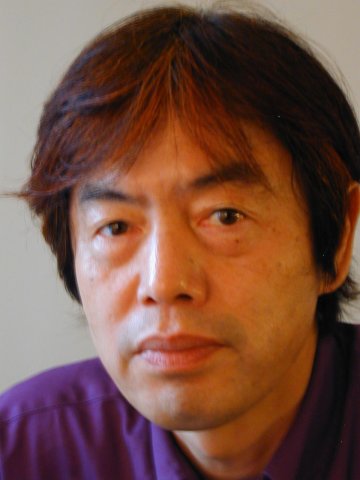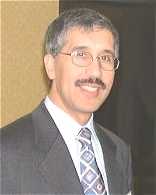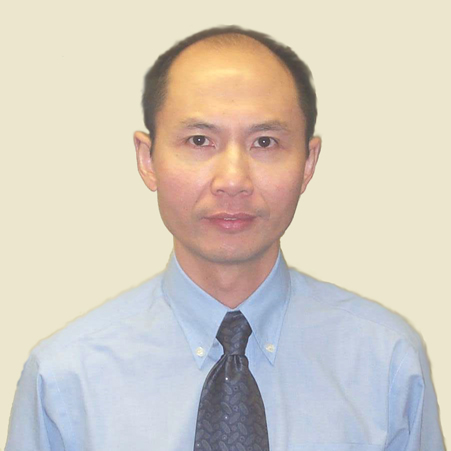|
Distinguished Invited Speakers
Animation Factory - A Reality?
By
Hock Soon Seah, School of Computer Engineering, Nanyang
Technological University, Singapore
 Abstract
: With the
availability of low cost powerful computer systems, fast network
connection, affordable large storages and improved algorithms,
we believe that traditional (2D) animation will make a comeback.
Although lower cost of computer infrastructure will also benefit
3D production, more is to be gained in 2D production, which is
more labor-intensive than its 3D counterpart. The 2D production
pipeline is very amendable to computerization as it was designed
for division of labor. The introduction of software system
forces standardization which will facilitate collaborative work
among a large group of people in different geographical
locations. Abstract
: With the
availability of low cost powerful computer systems, fast network
connection, affordable large storages and improved algorithms,
we believe that traditional (2D) animation will make a comeback.
Although lower cost of computer infrastructure will also benefit
3D production, more is to be gained in 2D production, which is
more labor-intensive than its 3D counterpart. The 2D production
pipeline is very amendable to computerization as it was designed
for division of labor. The introduction of software system
forces standardization which will facilitate collaborative work
among a large group of people in different geographical
locations.
In this talk, we
outline the concept of an Animation Factory, where the art and
craft of traditional animation is made accessible to and
embraced by more people. A good production pipeline and an
appropriate infrastructure will multiply the effort of artists
to deliver high quality animation at a reasonable cost. We
discuss some of the innovations that we have achieved in
developing a 2D animation production framework.
Biography
: Dr Hock Soon SEAH is the Dean of
the School of Computer Engineering at Nanyang Technological
University, Singapore. Concurrently, he had served as the Protem
Chairman of the NTU School of Art, Design and Media from March
2003 to February 2005 to oversee the conceptualisation and
development of the new art school.Seah serves in the Editorial
Board of Computer & Graphics Journal published by Elsevier. Seah
is the Founding President of both the ACM SIGGRAPH Singapore and
the South East Asian Computer Graphics Society (SEAGRAPH). He is
also the Leader of Digital Media Virtual Grid Community under
the Singapore National Grid Office. His current research areas
are in geometric modeling, image sequence analysis with
applications to digital film effects, automatic in-between frame
generation from hand-drawn sketches, augmented reality, 3D
profilometry and advanced medical visualization. He has been the
principal investigator of several research funds with a total
amount of more than $1.4 million. Currently, he is the leader of
the Computational Arts Group whose work on Interactive Free-Hand
Drawing and Animation System won a Bronze Award for the most
outstanding exhibit in the NTU College of Engineering Technology
Week Exhibition in May 2005. He was general co-chair with
Tosiyasu Kunii for the International Conference on Cyberworlds
in 2003 and 2005, general co-chair with Kim Machan for the
Multimedia Art Asia Pacific (MAAP) Conference on New Media Art,
Technology and Education and co-programme chair with Alan
Chalmers for the International Conference on Computer Graphics
and Interactive Techniques (GRAPHITE) in 2004. He holds a
Bachelor degree in Electrical Engineering, a Masters degree in
Computing Science and a PhD degree in Computer Graphics.
Entertainment and Robotics
By
Ryohei Nakatsu and Naoko Tosa, Kwansei Gakuin Univeristy/Kyoto
University,
Japan
 Abstract
:Even though in recent years
research and development of humanoid robots has increased, the
major topics of research generally focus on how to make a robot
perform specific motions such as walking. However, walking is
only one of the complicated motions humans can perform. For
robots to play an active role in society as our partner, they
must be able to simulate precisely various kinds of human
actions. Based on this consideration, we study and develop
various types of robot motions such as dancing, “Tai-chi,” and
“Noh.” Also by measuring our brain activities while we are
interacting with these robots that can perform such actions, we
want to show the importance of physical interactions between
human and computer. Abstract
:Even though in recent years
research and development of humanoid robots has increased, the
major topics of research generally focus on how to make a robot
perform specific motions such as walking. However, walking is
only one of the complicated motions humans can perform. For
robots to play an active role in society as our partner, they
must be able to simulate precisely various kinds of human
actions. Based on this consideration, we study and develop
various types of robot motions such as dancing, “Tai-chi,” and
“Noh.” Also by measuring our brain activities while we are
interacting with these robots that can perform such actions, we
want to show the importance of physical interactions between
human and computer.
Biography
: Ryohei Nakatsu received the B.S., M.S. and Ph.D. degrees in
electronic engineering from Kyoto University in 1969, 1971 and
1982 respectively. After joining NTT in 1971, he mainly worked
on speech recognition technology. In 1994, he joined ATR
(Advanced Telecommunications Research Institute) as the
president of ATR Media Integration & Communications Research
Laboratories. From the spring of 2002 he is a professor at
School of Science and Technology, Kwansei Gakuin University. At
the same time he established a venture company, Nirvana
Technology Inc., and became a president of the company. His
research interests includes nonverbal information processing,
nonverbal communications, and communication robot/agent. In
1978, he received Young Engineer Award from the Institute of
Electronics, Information and Communication Engineers Japan (IEICE-J).
In 1996, the best paper award from the IEEE International
Conference on Multimedia. In 1999, 2000 and 2001, Telecom System
Award from Telecommunication System Foundation and the best
paper award from Virtual Reality Society of Japan. In 2000, the
best paper award from Artificial Intelligence Society of Japan.
He is a fellow of the IEEE and the Institute of Electronics,
Information and Communication Engineers Japan (IEICE-J), a
member of the Acoustical Society of Japan, Information
Processing Society of Japan, and Japanese Society for Artificial
Intelligence.
Networked Appliances in Home Entertainment
By
Madjid Merabti, Liverpool John Moores University
 Abstract
:Networked Appliances offer many
opportunities to support the convergence of technology used in
Home Entertainment. These appliances involve many challenges in
connecting them reliably and seamlessly. This talk will focus on
efficient architecture, secure component composition and future
technology to enable their deployment aiming at home
entertainment devices integration. Abstract
:Networked Appliances offer many
opportunities to support the convergence of technology used in
Home Entertainment. These appliances involve many challenges in
connecting them reliably and seamlessly. This talk will focus on
efficient architecture, secure component composition and future
technology to enable their deployment aiming at home
entertainment devices integration.
Biography
: Madjid Merabti (www.cms.ljmu.ac.uk ; M.Merabti@ljmu.ac.uk) is
Professor of Networked Systems and Director of the School of
Computing & Mathematical Sciences, at Liverpool John Moores
University, UK. He has over 15 years experience in conducting
research and teaching in the areas of Computer Networks (fixed
and wireless), Mobile Computing, and Computer Network Security.
Prof. Merabti is widely published, over 100 publications, in
these areas and leads the Distributed Multimedia Systems and
Security Research Group, which has a number of UK Government,
EU, and industry supported research projects. He is principal
investigator in a number of current projects in Digital Rights
Management, Games Technology, Multimedia Networking, Mobile
Networks Security and Privacy Architectures and Protocols,
Secure Component Composition in Ubiquitous Personal Networks,
Networked Appliances, Mobile and Ad-Hoc Computing Environments,
and Sensor Networks. He is Co-Editor in-Chief for the
International Journal of Pervasive Computing and Communications
(JPCC), Associate Editor for IEEE Transactions on Multimedia,
Area Editor for Networked Appliances and Home Networking for
IEEE Communications Magazine, and a Member of Editorial Board
for the International Journal on Computer Communications. Madjid
Merabti has been technical programme chair for several
international conferences since 2000. Madjid Merabti is a member
of the EPSRC Peer College and Coordinator of a UK EPSRC funded
Network on the Convergence of Telecommunications, Networking,
and Broadcasting and which involves some of the major UK
Universities and Industry.
Rethinking Learning Games: Why They Must Evolve In Order To
Survive
By
Scot Osterweil, MIT Education
Arcade
 Abstract
:Play has no agenda. Children play for their own reasons, and
even though their play can exhibit fierce determination,
persistence, and a will to mastery, it does so only in the
service of goals that children set for themselves. Play is a
private entertainment space. It is distinct from school, where
some learning goals may be set by the child, but where more
commonly they are set externally, and where success is often met
with extrinsic rewards. To succeed, we must look at where the
strengths and challenges of both classrooms and games lie and
situate learning games at the most productive intersection of
these separate environments. We will examine these issues
through concrete examples of existing best practices, and
speculative designs currently under development at MIT's
Education Arcade, and elsewhere. Abstract
:Play has no agenda. Children play for their own reasons, and
even though their play can exhibit fierce determination,
persistence, and a will to mastery, it does so only in the
service of goals that children set for themselves. Play is a
private entertainment space. It is distinct from school, where
some learning goals may be set by the child, but where more
commonly they are set externally, and where success is often met
with extrinsic rewards. To succeed, we must look at where the
strengths and challenges of both classrooms and games lie and
situate learning games at the most productive intersection of
these separate environments. We will examine these issues
through concrete examples of existing best practices, and
speculative designs currently under development at MIT's
Education Arcade, and elsewhere.
Biography
: Scot Osterweil is the project manager for the Education Arcade and
currently directs "Learning Games to Go," a federally funded
project designed to develop mobile games that teach math and
literacy to underserved youth. Before coming to MIT, Scot was
the Senior Designer at TERC, an educational R&D firm. He
designed Zoombinis Island Odyssey, winner of the 2003 Bologna
New Media Prize, and the latest game in the Zoombinis line of
products (Riverdeep/TLC). Scot is the creator of the Zoombinis,
and with Chris Hancock he co-designed the multi-award winning
Logical Journey of the Zoombinis, and its first sequel,
Zoombinis Mountain Rescue. Scot is the also the designer of the
TERCworks games Switchback, and Yoiks!, the latter also with
Chris Hancock. Scot's other software designs include work on the
educational products Tabletop II, Tabletop and Tabletop Jr., and
IBM's The Nature of Science. At TERC he participated in research
projects on the role of computer games in learning, and on the
use of video in data collection and representation. Previously,
he worked in television, on the production of Public
Television's Frontline, Evening at Pops, and American Playhouse,
and as an animator on a wide range of programs. He is a graduate
of Yale College with a degree in Theater Studies.
Game AI - Industry vs. Academia - Round 1
By
Alexander Nareyek, interactive intelligence Labs (ii Labs)
 Abstract
:Academia and commercial game development are very different
animals, and so are their goals and processes. People often talk
at cross-purposes, and this leads to many misunderstandings. In
this talk, I will focus on the area of game AI, and provide an
overview and discussion of the different approaches and views.
Participants will also gain insights about selected AI
techniques and future directions. Don't expect, however, that
industry and academia are equally right in their approaches -
round 1 shouldn't end with a cliffhanger! Abstract
:Academia and commercial game development are very different
animals, and so are their goals and processes. People often talk
at cross-purposes, and this leads to many misunderstandings. In
this talk, I will focus on the area of game AI, and provide an
overview and discussion of the different approaches and views.
Participants will also gain insights about selected AI
techniques and future directions. Don't expect, however, that
industry and academia are equally right in their approaches -
round 1 shouldn't end with a cliffhanger!
Biography
: Alexander Nareyek directs the interactive intelligence Labs (ii
Labs) at the National University of Singapore, where he also
holds an assistant professorship. He received his diploma and
Ph.D. from the TU Berlin/Germany, held positions at GMD-FIRST/Germany,
Carnegie Mellon University/USA, and the Cork Constraint
Computation Centre/Ireland, and served as CEO and CTO for
Digital Drama Studios/Czech Republic. He is one of the leading
figures in the field of game AI and serves on numerous academic
and industrial committees. For the International Game Developers
Association (IGDA), he is responsible for matters regarding
artificial intelligence, and serves as chairperson of the IGDA's
Artificial Intelligence Interface Standards Committee.
Animating human and creature characters with procedurally
generated anatomical elements
By
Jian J. Zhang, Bournemouth University
 Abstract
: Realistic animation of human and creature characters requires
the skin shape deformation to be modelled in such a way that it
visually matches the characteristics of the character concerned.
Despite numerous research efforts, the development of skin
deformation techniques able to accommodate realism,
computational speed and ease of use in computer animation
remains a great challenge. Abstract
: Realistic animation of human and creature characters requires
the skin shape deformation to be modelled in such a way that it
visually matches the characteristics of the character concerned.
Despite numerous research efforts, the development of skin
deformation techniques able to accommodate realism,
computational speed and ease of use in computer animation
remains a great challenge.
Two broad skin deformation approaches exist. The first
involves the direct deformation of the character’s skin, whiles
the other is based on the character’s anatomy, mainly the
muscles. Although the former is widely adopted by the animation
industry, due to lack of reference to the underlying anatomical
structure, it is very difficult to represent a wide range of
possible skin deformations. On the other hand, the anatomy-based
skin deformation technique enables detailed visual realism to be
achieved. But unfortunately, one has to lay many individual
muscles on the skeleton before the character is skinned, making
it unintuitive to the animator.
In this talk, we present an anatomy-based technique that will
start with an already modelled character and procedurally works
out its underlying muscle structure by studying the surface
geometry of the skin. The extracted muscles are then used to
deform the skin in areas where there exist complex deformations.
This technique therefore combines advantages of both existing
approaches.
In order for the muscles to produce realistic local skin
deformation during animation, muscle bulging and special
movements are also studied. Whereas the former ensures volume
preservation, the latter allows a muscle not only to deform
along a straight path, but also to slide and bend around joints
and bones, resulting in the generation of sophisticated muscle
movements and deformations.
Biography
: Jian J Zhang is Professor of Computer Graphics and Director of
the Computer Animation Research Centre at Bournemouth
University. He received his PhD from Chongqing University in
1987. Since then he has worked at various universities including
Bristol University, University of Newcastle upon Tyne, Chongqing
University, Queens University of Belfast and Brunel University.
Jian Zhang is a member of many international programme
committees and has been involved in the organisation of a number
of international conferences and symposia. He is a member of
both AHRC and EPSRC Peer Review Colleges.
His research focuses on various issues of 3D computer
animation, including modelling, deformation, motion and
physically-based graphical simulation. He is also interested in
medical visualisation using computer graphical techniques. He
has undertaken many research projects funded by the AHRC, EPSRC,
DTI, charities, academic and industrial institutions. Jian Zhang
has been giving a number of invited and keynote lectures around
the world and produced over 100 peer reviewed publications.
|